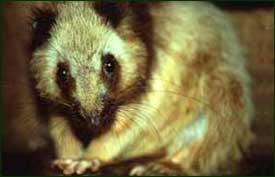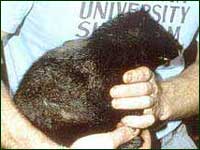Slender-Tailed Cloud Rat
Phloeomys pallidus
Rats and mice have a bad reputation. The very word "rat" in English immediately brings to mind a squinty-eyed, ugly, voracious, disease-ridden, aggressive animal that breeds prolifically unless constantly opposed through trapping and poisoning. There are, of course, such animals, and we all know them only too well. But most rat and mouse species are well-mannered, clean, rather pretty, and shy, and they pose no threat to humans. Of the 63 species of rats and mice in the Philippines, only six cause more than very minor damage to anything, and those six were all accidentily imported from the Asian mainland, and are not native to the Philippines. Each of the native species is an important of the food-web that binds together the rain-forest biological community. They range from such small and surprising species as the Isarog shrew-rat (mentioned at the beginning ofthis book) to such large and startling species are the slender-tailed cloud rats.
Weighing up to two and a half kilograms, the slender-tailed cloud rats (Phloeomys pallidus) are the largest "rats" in the world, using the taxonomic rather than the popular definition of a rat. But few people would recognize them as rats; most Americans and Filipinos would guess from their long, furry tails, large eyes, and quiet disposition that they are strange squirrels. The color pattern of one of the two known species of this rat,though, is different from any squirrel's: The species from central and northern Luzon is mostly covered in nearly white fur with dark ears, dark tail, and a dark brown mask around the eyes, nose, and mouth. Some populations have a brown cape over the shoulders. The species from southern Luzon (Phloeomys cumingi) is a deep mahogany brown all over; a group of related species, the bushy-tailed cloud rats, (the genus Crateromys), includes one species with long, flowing, coal-black hair covering theentire body, and another that is bright orange over most of the body, but with a tail that is pure white for the last half of its length.
As far as we know, all of the cloud rats feed on tender young leaves in trees that grow in lowland rain forest. They are slow-moving and seem to spend a great deal of time digesting their latest meal. In a large hollow tree or log, the females give birth to one young per year, which stays with the mother (the father hangs around only for mating) until the next young is born a year later. At one time, they probably were the primary prey for bird and mammal carnivores over much of the Philippines, possibly including the Philippine eagle in the Sierra Madre Mountains, where both the eagle and cloud rat were common until the end ofWorld War II.
Because they are large and meaty, the cloud rats are all heavily hunted; one subsistence farmer living at the base of Mount Isarog told us that he used his dogs to track and kill 50 per year. The combination of heavy hunting and habitat destruction has led to one species probably having gone extinct (on Mindoro), one that is critically endangered (on Panay), and the four others being threatened to varying degrees. Ironically, the cloud rats appear to be the only native species of "rats and mice" in the Philippines that have any economic impact, either positive or negitive. If the habitat were protected and hunting effectively regulated, they could remain asource of protein to poor farmers. Extinct species, however, are notoriously poor at providing any benefits.
Original URL: http://archive.fieldmuseum.org/vanishing_treasures/V_CRats.htm


